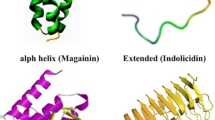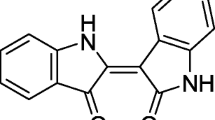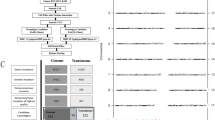Abstract
Natural and modified preparations of lipopolysaccharides and lipopolysaccharide-protein complexes isolated from the S- and R-form ofShigella dysenteriae serovar 1 were found to markedly inhibit the initial growth of mouse solid tumors derived from N’emeth-Kellner lymphoma, Gardner 6C3HED lymphoma, an ill-defined syngeneic lymphoma of DBA mice (Skalsky lymphoma) and LP-2 plasmacytoma. The biopreparations were given intraperitoneally, most frequently at a dose range from 50 to 200 μg per mouse; significant inhibitory effects on tumor growth were evidenced even in mice bearing tumors weighing 113 to 507 mg.
Similar content being viewed by others
References
Bloksma N., Hofhuis F.M.A., Willers J.M.: Muramyl dipeptide analogues as potentiators of the antitumor action of endotoxin.Cancer Immunol. Immunother. 19, 205–210 (1985).
Bonavida B., Gifford G.E., Kirchner H., Old L.J.:Tumor Necrosis Factor/Cachectin and Related Cytokines. S. Karger, Basel 1988.
Chedid L., Parant M., Pardut F., Peroux F., Perey J.J.: Hybridization by deoxycholate treatment or by biological degradation of bacterial endotoxins extracted from smooth and rough strains.Infect. Immun. 1, 15–20 (1970).
Fukushi K., Asano H., Sasaki J.: Bacterial endotoxins as an antitumor agent.Jap. J. Med. Sci. Biol. 35, 122–123 (1982).
Galanos C., Freudenberg M.A., Reutter W.: Galactosamine-induced sensitization to the lethal effects of endotoxin.Proc. Nat. Acad. Sci. 76, 5939–5943 (1979).
Homma J.Y., Kanegasaki S., Lüderitz O., Shiba T., Westphal O.:Bacterial Endotoxin. Chemical, Biological and Clinical Aspects. Verlag Chemie, Weinheim 1984.
Kodama M., Mizukuro T., Yamaguchi N., Yoshida S., Katayama Y.: The mechanism of antitumor activity of the bacterial endotoxins.Jap. J. Med. Sci. Biol. 36, 119–121 (1983).
Männel D.N.: Endotoxin activities of tumor necrosis factor independent of IL 1 secretion by macrophages/monocytes.Lymphokin Res. 6, 151–159 (1987).
Mather K., Fisher R.A.:Statistical Analyses in Biology. Springer Verlag, Wien 1954.
Nauts H.C., Fowler G.A., Bogatko F.H.: Review of the influence of bacterial infection and of bacterial products, (Coley’s toxins) on malignant tumors in man.Acta Med. Scand. 145, 3–103 (1953).
Niwa M., Milner K.C., Ribi E., Rudbach J.A.: Alteration of physical, chemical and biological properties of endotoxin by treatment with mild alkali.J. Bacteriol. 97, 1069–1077 (1969).
North R.J.: Bacterial endotoxin as an immunotherapeutic agent—basic data on mechanisms of action, pp. 113–124 inAugmenting Agents in Cancer Therapy (E.M. Hersch M.A. Chirigos, M.J. Mastrangelo, Eds). Raven Press, New York, 1981.
Noso Y., Parant M., Chedid L.: Production of tumor necrosis factor in nude mice by muramyl dipeptides associated with bacterial vaccines.Cancer Res 48, 5766–5769 (1988).
Nowotny A.:Beneficial Effects of Endotoxins. Plenum Press, New York 1983.
Onozaki K., Hashimoto T.: Different mechanisms of macrophage activation with guinea pig macrophage activation factor, lipopolysaccharide and muramyl dipeptide.Int. Arch. Allergy Appl. Immunol. 76, 296–301 (1985).
Oravec C., Kmety E.: Experimental biotherapy by leptospiral infection. Quantitative titration on the tumoricidal effect of leptospiral exoproducts by means of Cr-labeled target cells of mouse ascites tumors.Neoplasma 28, 705–708 (1981).
Raynaud M., Digeon M.: Sur une nouvelle toxine du bacille typhique extraite des formes rough.CR Acad. Sci. 229, 564–566 (1949).
Ribi E., Amano K., Cantrell J., Schwartzman S., Parker R., Takayama K.: Preparation and antitumor activity of nontoxic lipid A.Cancer Immunol. Immunother. 12, 91–96 (1982).
Sayers T.J., Macher I., Chung J., Kugler E.: The production of tumor fecrosis factor by mouse bone marrow-derived macrophages in response to bacterial lipopolysaccharide and a chemically synthesized monosaccharide precursor.J. Immunol. 138, 2935–2940 (1987).
Shear M.J., Turner F.C., Perrault A., Shovelton T.: Chemical treatment of tumors. V. Isolation of the hemorrhage-producing fraction fromSerratia marcescens (Bacillus prodigiosus) culture filtrate.J. Nat. Cancer Inst. 4, 81–97 (1943).
Šourek J., Trnka T., Digeon M., Raynaud M.: Some immunochemical and chemical aspects of S and RShigella dysenteriae 1 endotoxins.J. Hyg. Epidem. Microbiol. Immunol. 19, 356–374 (1975).
Šourek J., Jandejsek J., Levin J.: Effect of detoxification processes on the interferon-inducing activity of bacterial endotoxins.Acta Microbiol. Hung. 36, 439–443 (1989).
Šourek J., Prušov’a D., Holan Z., Wünschov’a M.: Tumor necrosis factor and its induction by bacterial endotoxins.J. Hyg. Epidemiol. Microbiol. Immunol. 35, 317–324 (1991).
Sultzer B.M., Craig J.P., Castagna G.:Immunomodulation by Outer Membrane Proteins Associated with the Endotoxin of Gram-negative Bacteria. Immunopharmacology of Infectious Diseases: Vaccine Adjuvants and Modulators of Nonspecific Resistance. Allan R. Liss, New York 1987.
Westphal O., Lüderitz O., Staub A.M., Nikaido H.: Isolation and chemical and immunochemical characterization of bacterial lipopolysaccharides, pp. 145–233 inMicrobial Toxins, Vol. 4 (G. Weinbaum, S. Kadis, S.J. Ajl, Eds). Academic Press, New York 1971.
Author information
Authors and Affiliations
Rights and permissions
About this article
Cite this article
Šourek, J., Oravec, C. & Männel, D.S. Bacterial endotoxins as potential antitumor agents. Folia Microbiol 37, 450–454 (1992). https://doi.org/10.1007/BF02899904
Received:
Issue Date:
DOI: https://doi.org/10.1007/BF02899904




